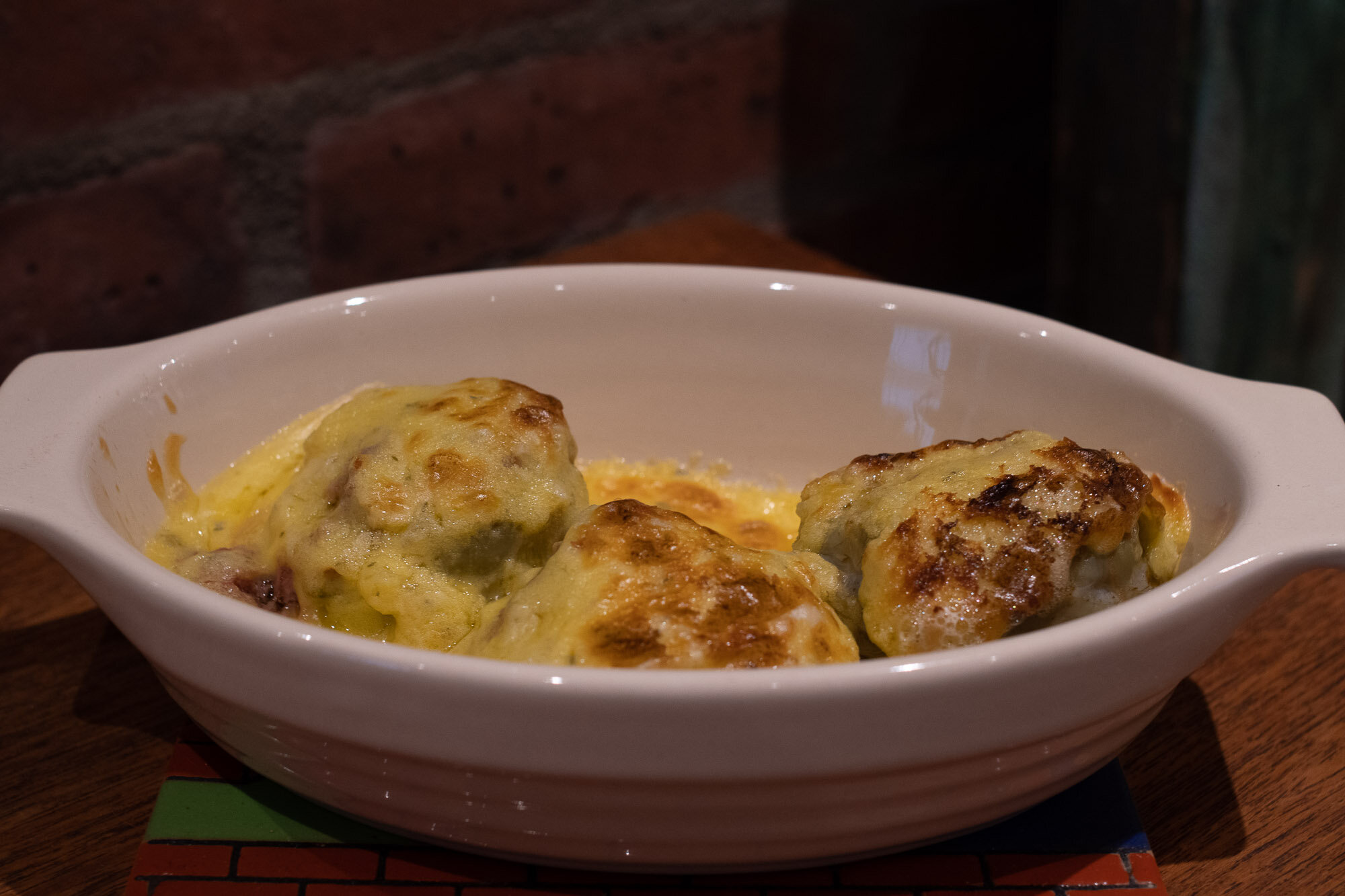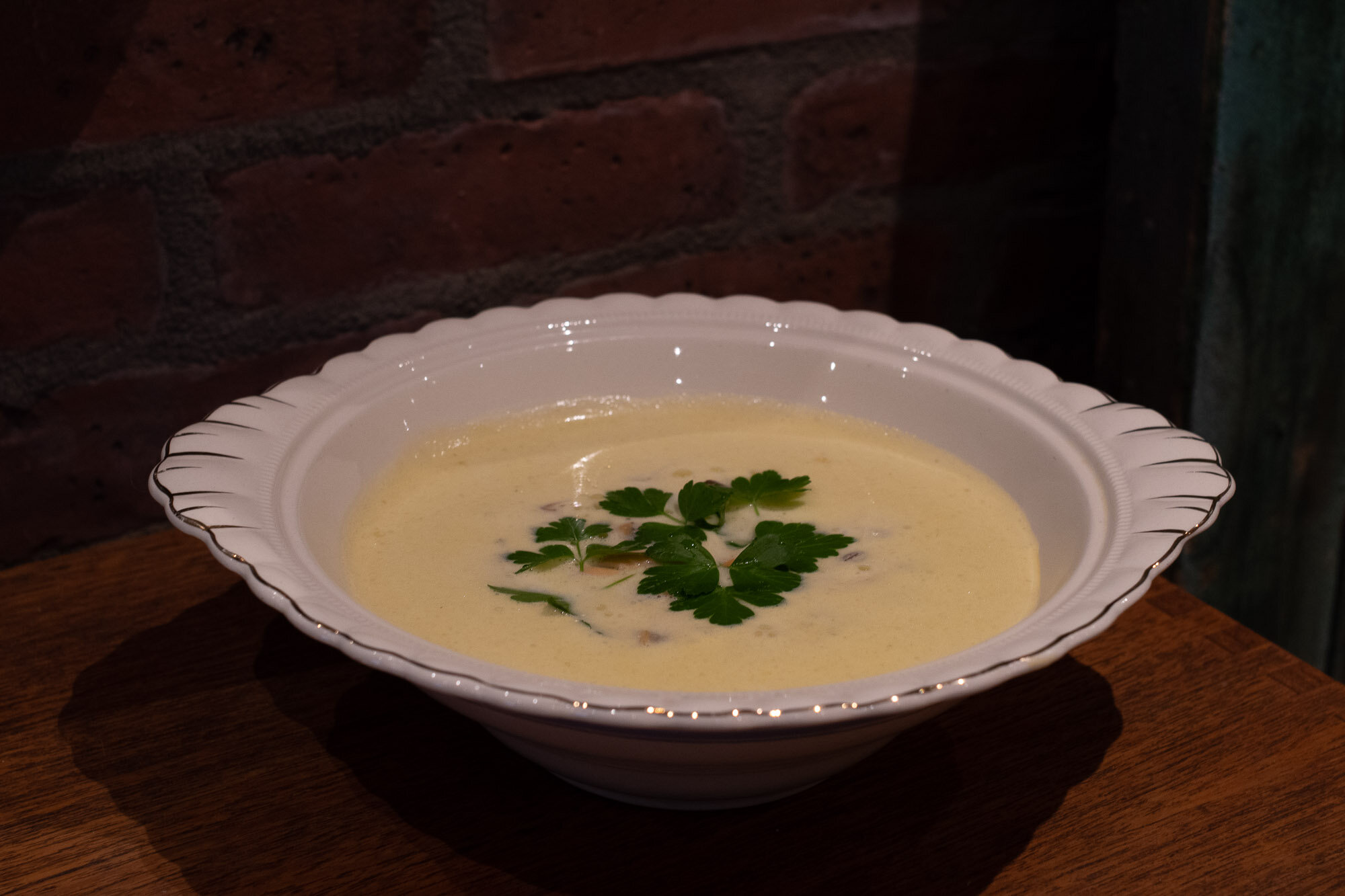Dining in Toronto: Café de l’Auberge
Cover image: Four Seasons Hotels Limited Annual Report (1975)
Our next Toronto meal takes us to a disco-turned-dining room from the 1960s: Café de l’Auberge was once the main dining room of Toronto’s Inn on the Park Hotel, formerly located at 1100 Eglinton Avenue East. Today, you’ll find a large Lexus-Toyota dealership and (what else?) condo buildings on the spot. But the former hotel must have had beautiful vistas: looking out over farmland and parks.
Table of Contents:
Inn on the Park
1100 Eglinton Avenue East
Inn on the Park opened in May 1963 by the young Four Seasons Hotel chain. The company had opened its first hotel in 1961 on Jarvis Street, but wanted to expand its reach beyond metro Toronto. A four-acre parcel of North York farmland was chosen for the hotel site, close to the Don Valley Parkway. Surrounded by 600 acres of parkland, the hotel had a secluded, resort-like atmosphere.
City of Toronto Archives
A lounge at Inn on the Park. City of Toronto Archives, Series 2, Fonds 607, File 164.
Hoping to appeal to business travellers and their families, the Inn on the Park was built to include the latest amenities: an Olympic-sized swimming pool, golf course, and even (unusual for the 1960s), an on-site health club. Located so far from downtown, the hotel also offered its guests on-site entertainment, opening Café Discotheque in 1964, one of Canada’s first discos.
But djs and disco failed to attract enough clientele and the Four Seasons eventually closed its doors to focus on fine dining. When the hotel had opened, it featured two dining rooms: the Vintage Room and the Buttery. To this, the Café de l’Auberge was added, opened in the disco’s former space. Focusing on fine French cuisine, the restaurant quickly became a favourite for those celebrating special occasions.
Cafe de l’Auberge illustration from the Toronto Star, November 5, 1980. Illustration by John Izod
We knew when we looked at the menu for Café de l’Auberge that we were in for a challenge. Dinner for six with seven courses. Plus cocktails!
Menu:
Communard (our apéritif)
Fonds d’Artichauts à ma Façon
Velouté de Moule Océanne
Salade Gourmande
Suprêmes de Volaille Julie Wilson with Gratin Dauphinois
Jardinière de Légumes
Mousse en Surprise William
Plus wine pairings:
Appetizer: Saint-Véran
Dinner: Beaujolais Juliénas
At the time, the Chef de Cuisines of Inn on the Park’s premier restaurant was Edward Mérard. He was no slouch. Winner of the Maîtrise Escoffier avec Medaille in 1967 and the Cordon Culinaire avec Medaille in 1974, Mérard had been the executive chef at lauded hotel restaurants all over the world. Born in France, he worked at the Ritz-Carlton Chicago, the Queens in Leeds, the Gleneagles Hotel in Scotland. After a move from Toronto to Montreal in the early 1980s, he spent the rest of his career at the Queen Elizabeth Hotel.
With a chef like that behind the menu, we knew there’d be no scrimping, no shortcuts. We weren’t wrong.
Apéritif: Communard
The Communard is a simple blend of red wine and crème de cassis. But a deep dive behind this drink takes us on a surprising journey from medicinal herbs to freedom-fighting Frenchmen.
Image by Mike Portt
A few of us might be used to a mixed drink during happy hour or a round at the bar before dinner begins, but the Communard cocktail comes from a long tradition of apéritifs, drinks specifically designed to stimulate the appetite before a meal. A tradition believed to have been introduced in the mid-19th century in France, the apéritif often was flavored with spices or herbs thought to help “open the palette” (the word coming from the Latin word “aperire”, meaning literally “to open”).
There are many varieties of aperitifs: often alcohols enjoyed by themselves, such as sherry or pastis. But they can also be mixed drinks. If you’ve heard of any mixed drink styled as an aperitif, you may have heard of a “kir”, a very typical French cocktail, made with white wine mixed with crème de cassis (blackcurrant liqueur). Previously known as a blanc-cassis, the name “kir” became popular in honor of Félix Kir (1876-1968).
The inspiration behind the Kir cocktail: Félix Kir (1876-1968).
Kir was a legend: A member of the French Resistance during World War II, escaping imprisonment by the German army and death on several occasions. After the war, Kir was elected mayor of Dijon, where he embarked on a whirlwind promotional campaign to attract international investors to the region. He eventually allowed his name to be used by a local producer of crème de cassis to market their products, helping fuse his name to the aperitif.
Let’s get back to the Communard: often considered a variant of the “kir”, swapping red wine for the traditional white. But, at least according to some, red may have been the original wine of choice for this aperitif in France. When German soldiers confiscated the red Burgundy of the region during World War II, locals swapped to using white in the cocktail instead, eventually naming the white wine version after their local war hero Kir.
But the Communard’s name may suggest older origins than freedom-fighting Félix. In France, Communards were those who supported the short-lived Paris Commune of 1871. At the time, the working class of Paris felt ostracized and abandoned by the national French government: suffering through food shortages and war for years. In early 1871, many Parisians, along with members of the National Guard, rebelled and formed their own independent government in Paris, calling it a new “commune” (hence their name: “Communards”).
Communard barricade in Paris at the Chaussée Ménilmontant, March 18 1871. Courtesy of Paris Musées.
From March to May 1871, Paris was a Communard state. Eventually, the Communards were routed by the national French Army in late May of 1871. Over 6,000 Communards were killed and many others were forced into exile. Although the Paris Commune was eventually a failed experiment, it became an international flashpoint: Karl Marx and Frederich Engels both looked to the Communards in their political writings. Subsequent working-class uprisings in other countries often invoked the Paris Commune, including Russia’s “February Revolution” in 1917, which led to the abdication of Tsar Nicholas II.
The red flag in action. Close-up section of "Lamartine, before the Hôtel de Ville, Paris, rejects the Red Flag," February 25, 1848. By Henri Felix Emmanuel Philippoteaux (1815–1884).
But let’s get back to the cocktail itself. France being France, a red wine and crème de cassis concoction doesn’t go by just one name, but two. According to some, If the drink is made with a pinot noir red Burgundy, the drink is known as a “cardinal” (perhaps after the red outfit). However, if the drink is made with a Beaujolais (made from Gamay grapes), that’s the true Communard. Although many insist that the distinction in the two names indicates more of political leaning than grape varietal: with those on the political left preferring the Communard name for the drink, with those on the right preferring to call it a “cardinal.”
But, if the red color of the drink can be explained by its reference the cardinal’s robes: what’s the link to a proletariat protest? Many believe the color refers to the red flag used by the Communards. Without digging into a whole history of flags: yes, the Communard red flag can be linked to red flags often associated with communism (such as those of the Russian Revolution and the USSR), but the red flag had long been a symbol of rebellion and resistance. In France, the Jacobins had made the red flag a national emblem during the Reign of Terror in the 1790s. The solid red flag was again used as a symbol of protest in the French Revolution of 1848.
Not a bad history for a starting drink, eh?
Appetizer, Soup, and Salad
The first three courses of the Auberge menu were opulent variations on French classics. Remind me never to volunteer for artichoke peeling duty ever again…



Main Course: Suprêmes de Volaille Julie Wilson with Gratin Dauphinois
Julie Wilson in 1956, Photo by Bruno Bernard.
It’s a quirky but long-held tradition for chefs to name dishes after celebrities or influential figures. Even in this menu, we’ve already seen one celebrity-inspired recipe with the kir. But it’s not just cocktails: the meringue-based dessert, the pavlova, was named for Russian ballet dancer Anna Pavlova (1881-1931). The margherita pizza was reputedly named for Queen Margherita of Savoy (1851-1926). Oysters Rockefeller pays homage to John D. Rockefeller (1839-1927), once one of the richest men in the United States.
But who knows how many recipes named for celebrities have been developed over the years? And how many have faded, for one reason or another, into obscurity.
For the Auberge’s main course, we have a variation on Chicken Supreme, a French-inspired recipe involving a boneless skinless chicken breast. We’ll cover the specifics of this recipe below, but first let’s address the other part of the title: who was Julie Wilson?
The recipe notes for this Auberge dish in Dining in Toronto don’t explain the name of the dish. But, if Mérard was adhering to tradition of naming dishes for celebrities, at the time when this book was published, there was a very famous Julie Wilson, certainly famous enough to inspire a chicken dish. Known as the Queen of Cabaret, Julie Wilson (1924-2015) was a star of stage and screen.
An ad for Julie Wilson’s shows at the Washington DC Ritz-Carlton. Philadelphia Daily News, February 6, 1987, p. 72
Wilson was beloved as a “saloon singer”, often performing at luxury hotels in New York, Washington DC, and Chicago. Wilson even performed her act at various Ritz-Carltons throughout the career.
Although we can’t find any evidence that she performed at the Chicago Ritz-Carlton while Mérard would have been head chef, we do know she performed at the Ritz in Washington DC throughout the 1980s.
A Mysterious Recipe
But whether this famous Julie Wilson is the Julie Wilson of the recipe? We may never know. In a October 3, 1984 interview with the Montreal Gazette, Mérard was asked about the namesake of his Julie Wilson chicken dish (which in this version is referred to as Poulet Saute Julie Wilson), but the chef demurred in providing any explanation as the person who inspired it, “[Chef Mérard] refused to elaborate on the person honored in the recipe title.” Within the article, it’s revealed that Mérard had developed the dish while working at the Gleneagles Hotel in Scotland, prior to his arrival at the Auberge.
Was this chicken dish Mérard’s humble way of honoring his favorite saloon singer? Or was there another Julie Wilson in Mérard’s life who inspired this very 1970s poultry concoction? We may never know.
Image by Mike Portt
A Supremely 1970s Chicken Recipe
Chicken Supreme, aka Sûpreme de Volaille, in French cooking can refer to recipes that call for a boneless, skinless chicken breast. However, France being France, Supreme can also refer to the sauce that’s often served alongside it: aka sauce suprême. Traditionally made with a base of heavy glug of cream and chicken stock, the sauce can be infinitely customized.
A chicken breast in sauce was a tried-and-true and oft-repeated dish for both professional and home chefs throughout North America and Europe in the 20th century. Home cookbooks, whether published in 1920 or 1980, reveal endless variations on Chicken Supreme. Some were clearly intended for more formal gatherings, such as the “Company Chicken Supreme” from 1955. By the 1980s, American cooks seemed to be slightly tiring of the omnipresent dish, as The Great American Cookbook’s describe a standard supreme as a “bland-tasting, anonymous concoction.”
Company Chicken Supreme from The Good Housekeeping Cookbook (1955), p. 198
Creamed Chicken Supreme from Iona Dixon’s The Great American Chicken Cookbook (1982), p. 96
Mérard clearly wasn’t reinventing the wheel by devising a chicken breast recipe with a sauce. But, his choice of ingredients for the supreme sauce are a tad avant-garde, at least for the 1970s. In addition to the classic ingredients of chicken stock, cream, and brandy, Mérard recommended adding a teaspoon of instant coffee to the sauce, as he says in the recipe notes: “Instant coffee adds a special piquant taste, and everyone will wonder what the extra added ingredient is!” Mérard may have been attempting to infuse a little life in the stale recipe.
Dessert: Mousse en Surprise William
















